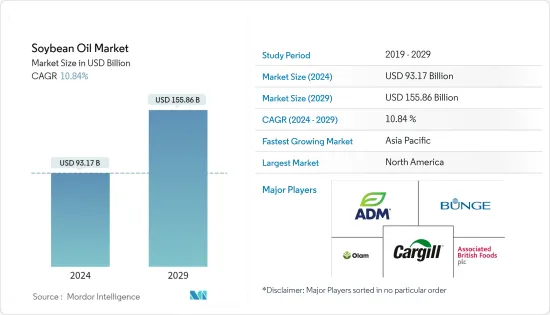 |
市場調査レポート
商品コード
1435202
大豆油- 市場シェア分析、産業動向・統計、成長予測(2024年~2029年)Soybean Oil - Market Share Analysis, Industry Trends & Statistics, Growth Forecasts (2024 - 2029) |
||||||
● お客様のご希望に応じて、既存データの加工や未掲載情報(例:国別セグメント)の追加などの対応が可能です。 詳細はお問い合わせください。
| 大豆油- 市場シェア分析、産業動向・統計、成長予測(2024年~2029年) |
|
出版日: 2024年02月15日
発行: Mordor Intelligence
ページ情報: 英文 100 Pages
納期: 2~3営業日
|
- 全表示
- 概要
- 目次
大豆油市場規模は2024年に931億7,000万米ドルと推定され、2029年までに1,558億6,000万米ドルに達すると予測されており、予測期間(2024年から2029年)中に10.84%のCAGRで成長します。

主なハイライト
- 他の植物性食用油と比較した大豆油の利点に対する消費者の意識の高まりにより、その需要が大幅に増加しました。
- 中国、米国、ブラジル、インドは大豆油を消費する世界の主要国です。
- 大豆油は、低コスト、入手しやすさ、環境に優しい性質により、食品、工業、飼料などのさまざまな分野での使用がさらに促進されています。大豆油は、接着剤やシーラントとして有用なコーキング材やマスチックの製造など、さまざまな食品や工業用途にも使用されています。
大豆油市場動向
バイオディーゼルにおける大豆油の使用量の増加
大豆の作付面積は他の脂肪種子作物よりもはるかに多く、そのため大豆油が大量に生産され、バイオ燃料原料として利用可能となっています。バイオディーゼルの生産に大豆油を使用することには多くの利点があります。大豆は広く栽培されているため、大豆を栽培、輸送、加工するためのインフラと設備はすでに存在しています。さらに、残った大豆粕は動物の飼料として重要です。バイオディーゼルへの大豆油の使用は、米国大豆農家による米国大豆委員会(USB)を通じた促進と、その後の国家バイオディーゼル委員会(NBB)の創設に大きな影響を受けました。 EIAによると、バイオディーゼル原料として消費される大豆油の総割合は、2010~11年の約15%から2017~18年の30%へと倍増しました。
北米が市場で卓越したシェアを保持
バイオディーゼルは国内の大豆油の消費量の増加につながっています。食料需要の低迷は、大豆油を主要原料として使用する米国のバイオディーゼル生産の増加によって相殺されます。 USDAの報告によると、大豆生産量は当初(2010/11~2011/12)減少しましたが、その後徐々に増加し、収量と作付面積はわずかに改善しました。米国の大豆供給量は増加すると予想されており、国内での使用と輸出は緩やかに増加すると思われます。しかし、米国の大豆産業は海外との競合激化に直面し、米国の農家が作付面積を飼料用穀物にシフトしているため、今後数年間で成長が鈍化する可能性が高いです。大豆の純収益は異常に高い水準に上昇する可能性が高いもの、トウモロコシよりも低いことが予想され、その結果、米国の大豆作付面積は徐々に制限されることになります。
大豆油産業の概要
世界の大豆油市場は統合されており、大手企業が市場で顕著なシェアを占めています。大豆油の多用途性が好機として浮上し、世界中の食品分野の多くのメーカーを魅了すると予想されます。市場の主要企業は、Cargill Inc.、Bungee Limited、ADM、Associated British Foods PLCです。
その他の特典
- エクセル形式の市場予測(ME)シート
- 3か月のアナリストサポート
目次
第1章 イントロダクション
- 調査の前提条件と市場定義
- 調査範囲
第2章 調査手法
第3章 エグゼクティブサマリー
- 市場概要
第4章 市場力学
- 市場促進要因
- 市場抑制要因
- ポーターのファイブフォース分析
- 新規参入業者の脅威
- 買い手・消費者の交渉力
- 供給企業の交渉力
- 代替品の脅威
- 競争企業間の敵対関係の強さ
第5章 市場セグメンテーション
- 用途別
- 食品
- スプレッド
- ベーカリー・菓子類
- その他の用途
- 動物飼料
- 工業
- 食品
- 地域
- 北米
- 米国
- カナダ
- メキシコ
- その他北米地域
- 欧州
- 英国
- ドイツ
- フランス
- イタリア
- スペイン
- ロシア
- その他欧州
- アジア太平洋
- 中国
- 日本
- インド
- オーストラリア
- その他アジア太平洋地域
- 南米
- ブラジル
- アルゼンチン
- その他南米
- 中東・アフリカ
- 南アフリカ
- サウジアラビア
- その他中東とアフリカ
- 北米
第6章 競合情勢
- 最も活発な企業
- 最も採用されている戦略
- 市場シェア分析
- 企業プロファイル
- Archer Daniels Midland Company
- Associated British Foods PLC
- Bungee Limited
- Cargill Incorporated
- Corteva
- Olam International
- Wilmar International Ltd
- Granol
第7章 市場機会と今後の動向
The Soybean Oil Market size is estimated at USD 93.17 billion in 2024, and is expected to reach USD 155.86 billion by 2029, growing at a CAGR of 10.84% during the forecast period (2024-2029).

Key Highlights
- The growing awareness among consumers regarding the advantages of soybean oil, in comparison to other vegetable edible oils, has driven its demand significantly.
- China, the United States, Brazil, and India are the major countries in the world that consume soybean oil.
- Low cost, easy availability, and the eco-friendly nature of soybean oil have further facilitated its use in various sectors, such as food, industrial, and feed. Soybean oil is also used in various food and industrial applications, such as for production of caulks and mastics, which are useful as adhesives or sealants.
Soybean Oil Market Trends
Growing Usage of Soybean Oil in Biodiesel
Soybean acreage is much greater than other oilseed crops, leading to substantial soybean oil production and its availability as a biofuel feedstock. There are many benefits to using soybean oil in the production of biodiesel. As soybeans are widely grown, the infrastructure and equipment to grow, transport, and process them already exists. Moreover, the leftover soybean meal is important for animal feed. The use of soybean oil for biodiesel was greatly influenced by the promotion from US soybean farmers through the United Soybean Board (USB) and the subsequent creation of the National Biodiesel Board (NBB). According to the EIA, the total share of soybean oil consumed as a biodiesel feedstock doubled, from about 15% in 2010-11 to 30% in 2017-18.
North America Holds a Prominent Share in the Market
Biodiesel is leading to the increase of the consumption of soybean oil in the country. The weak food demand is offset by theincrease in the US production of biodiesel, which uses soybean oil as a major feedstock. As per the USDA reports, soybean production declined initially (2010/11-2011/12) and then increased incrementally, with a modest improvement in yields and planted acreage. The expected growth in the US soybean supply will allow for a moderate rise in the domestic use and exports. However, the growth of the US soybean industry is likely to slow over the next few years, as it faces stronger foreign competition and the US farmers are shifting their acreage into feed grains. Although the net returns for soybeans is likely to rise to uncommonly high levels, they are expected be lower than that of corn, and as a result, gradually limit the US soybean acreage.
Soybean Oil Industry Overview
The global soybean oil market is consolidated, with the major players holding a prominent share in the market. The versatility of soybean oil is expected to emerge as an opportunity, and thereby, attract many manufacturers in the food products sector across the world. The major players in the market are Cargill Inc., Bungee Limited, ADM, and Associated British Foods PLC.
Additional Benefits:
- The market estimate (ME) sheet in Excel format
- 3 months of analyst support
TABLE OF CONTENTS
1 INTRODUCTION
- 1.1 Study Assumptions and Market Definition
- 1.2 Scope of the Study
2 RESEARCH METHODOLOGY
3 EXECUTIVE SUMMARY
- 3.1 Market Overview
4 MARKET DYNAMICS
- 4.1 Market Drivers
- 4.2 Market Restraints
- 4.3 Porter's Five Forces Analysis
- 4.3.1 Threat of New Entrants
- 4.3.2 Bargaining Power of Buyers/Consumers
- 4.3.3 Bargaining Power of Suppliers
- 4.3.4 Threat of Substitute Products
- 4.3.5 Intensity of Competitive Rivalry
5 MARKET SEGMENTATION
- 5.1 By Application
- 5.1.1 Food
- 5.1.1.1 Spreads
- 5.1.1.2 Bakery and Confectionery
- 5.1.1.3 Other Applications
- 5.1.2 Animal Feed
- 5.1.3 Industrial
- 5.1.1 Food
- 5.2 Geography
- 5.2.1 North America
- 5.2.1.1 United States
- 5.2.1.2 Canada
- 5.2.1.3 Mexico
- 5.2.1.4 Rest of North America
- 5.2.2 Europe
- 5.2.2.1 United Kingdom
- 5.2.2.2 Germany
- 5.2.2.3 France
- 5.2.2.4 Italy
- 5.2.2.5 Spain
- 5.2.2.6 Russia
- 5.2.2.7 Rest of Europe
- 5.2.3 Asia-Pacific
- 5.2.3.1 China
- 5.2.3.2 Japan
- 5.2.3.3 India
- 5.2.3.4 Australia
- 5.2.3.5 Rest of Asia-Pacific
- 5.2.4 South America
- 5.2.4.1 Brazil
- 5.2.4.2 Argentina
- 5.2.4.3 Rest of South America
- 5.2.5 Middle-East & Africa
- 5.2.5.1 South Africa
- 5.2.5.2 Saudi Arabia
- 5.2.5.3 Rest of Middle-East & Africa
- 5.2.1 North America
6 COMPETITIVE LANDSCAPE
- 6.1 Most Active Companies
- 6.2 Most Adopted Strategies
- 6.3 Market Share Analysis
- 6.4 Company Profiles
- 6.4.1 Archer Daniels Midland Company
- 6.4.2 Associated British Foods PLC
- 6.4.3 Bungee Limited
- 6.4.4 Cargill Incorporated
- 6.4.5 Corteva
- 6.4.6 Olam International
- 6.4.7 Wilmar International Ltd
- 6.4.8 Granol
